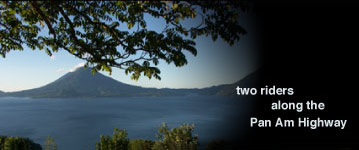
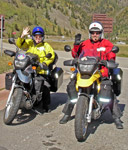
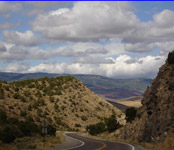
view corresponding gallery | previous entry | next entry
entry 18: costa rica 03/26/06
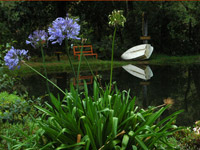 |
| An idyllic example of the Pura Vida in Costa Rica. |
Pura Vida. Pure Life. This is the national slogan of Costa Rica and they take it seriously. To us it could have meant, “you made it!” This border crossing was the most straight-forward of all border crossings to-date with the exception of the US/Canadian border. It had a well-shaded parking area with a very noticeable lack of street kids, border guides and money changers. No human swarm of any kind. And there was another obvious absence. No guards with shotguns or machine guns. It turns out that Costa Rica has no standing army and they don’t feel it necessary to guard banks and jewelry stores with anything more than pistol-toting guards. We were approached individually for offers of guide and money changing services but it was not the chaos of other Central American countries. It still took two hours to complete all tasks but then we were on the road to Liberia.
Liberia is the first significant town you come across when entering the country from the Pacific north. It was lunch time and when we spotted our favorite Latin-American chicken joint, Campero, we pulled in for a bite. We first came upon this place in Guatemala and have been patrons ever since. Their chicken makes good-old KFC seem laden with lard. While waiting for our food, we struck up a conversation with a guy sitting at the next table. Turns out he too had ridden into town on a motorcycle…16 years ago! And he has been here ever since. A wife and two kids later he is now running an adventure tour company that, at that moment, had eight teams of four people racing across Costa Rica. These teams traverse the country by means of bicycles, rafts, jeeps, kayaks and their own two feet. The winners get a cash prize as do the second and third place teams. Sounds like a good time!
Liberia itself was a perfect size to feel comfortable in and had all the amenities we needed – not to mention a Pizza Hut and a large grocery store. The only downside to the town was the non-stop wind, which is said to be seasonal and caused by Caribbean breezes that pick up speed coming over the mountains that lay just east of town. We stayed at a hotel that had mango trees in their courtyard and twice I nearly got beaned by wind-propelled fruit. Mangos are so prevalent here that the grocery store almost gives them away and they are DELICIUOS! Another tasty local delicacy we had were grilled plantains, which look like a banana but contain much more starch and are not nearly as sweet. A local grill down the street had a great recipe. The plantains are put on the grill still in their skin and covered with a wrought-iron lid until the whole peel is blackened. Then the plantain is sliced open and honey and butter and a white cheese are added on top – then cooked for a few more minutes. Very tasty for an afternoon treat!
Now the bad news. While in Liberia we discovered that our computer, an HP Pavilion, had stopped working - a little disappointing since it is our main tool for updating the website and storing our photos. I think the cobblestone-like mountain roads of Guatemala and the unavoidable potholes had finally taken their toll. The nearest computer repair shop was in San Jose and so we would have to wait until then to have it looked at.
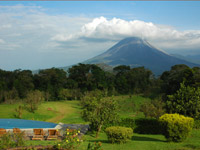 |
| Our view from the lodge - about 7km from the Arenal Volcano. |
Next up was Lake Arenal and the volcano of the same name, which means “Made of Sand.” The lake is the second largest in Central America and it is man made. We rode on pavement for a while which then turned into washboards, pot holes and stones for the last 10 miles to our hotel. We later found out the ironic story about the crappy section of road. It turns out that this section is in the middle of a tax dollar dispute between San Jose (to the south) and Liberia (to the north). It seems that each thinks this section should be maintained by the other, so at the current time (and apparently for quite some time) there are ZERO funds being spent for road upkeep. Slow going turned out to be a good thing because on one particular tight curve we hit the brakes for a group of White-Nosed Coatis that were crossing the road. Similar to a raccoon, they actually approach you out of simple curiosity, or as one carload of tourists proved – food.
We found the entrance to our hotel, the Arenal Lodge, and began what was to become a 1.7 mile climb up a lane made of moss covered paving stones that climbed the side of a good-sized hill. We just kept going up and up – and laughed when we got to the top – the sign read “You Made It!” From this vantage point, the view of the volcano was incredible and made the ride worth it. We unloaded the bikes and parked ourselves on our balcony to admire the volcano. Within a few minutes, two huge blue Macaws swooped in and landed on the deck next to us. We were able to observe them at close range for a long time. These birds are very territorial and had claimed this hotel for their own. We had a great steak dinner and then booked a couple of eco-tours for the upcoming days.
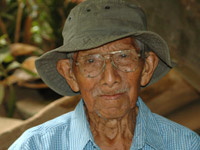 |
| The gracious Don Vincent welcomed us to their island. |
Our first excursion was a raft ride down the Penas Blancas River with a guide. The river is slow flowing this time of year (dry season or “summer” to the locals) and had only mild rapids. During the rainy season the water is 30 feet higher and fast moving - and wouldn’t allow for much animal spotting. Reptiles were most common, with “Jesus Christ” lizards and iguanas around every bend, but the best critter we saw was the 6-foot crocodile, slipping into the water as soon as we spotted it. The howler monkeys were abundant and vocal as we floated past. After two hours in the raft we stopped at the farm of Don Pedro. “Don” is not his first name but rather a term of respect given to the patriarchs of families. Don Pedro, aged 97 years, had broken his hip two weeks earlier when he fell while greeting guests. From his bed, Don Pedro still insisted on seeing visitors and we were quite taken by his generosity, kindness and courage when we met him. His family treated us to homemade bread, cheese, fried plantains and coffee. Then we met his younger brother, Don Vincent, who at the age of 93 had taken over the task of greeting visitors - and who would be a great match for our grandmother, Nana!
We returned to our hotel to hang out on the deck - and we were enjoying the view when an animal I can only describe as a large black ferret with long legs came onto the deck. It is called a black tyra and it also makes it home at the lodge. This place was turning out to be just like “Mutual of Omaha’s Wild Kingdom”! That night we also spotted a giant horned beetle climbing the side of a tree and during the day butterflies the size of my hand float by.
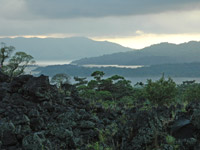 |
| The lava field and Arenal Lake (once Arenal Town) at dusk. |
The next day we took a hike up to the Arenal Volcano. We started late in the afternoon and followed a trail that began in the forest/jungle below the volcano and then leading us out onto a lava flow field. Because this volcano is composed mostly of sand (silica), the eruptions that occur every 20 minutes produce red-hot boulders that can be seen bouncing down the side of the volcano, crashing into the shrubs and grasses that cling to its side. Climbing at dusk provides you the best lighting for watching these rolling fireballs. Our guide was great – his knowledge of the area and the volcano’s history was profound – and he was even able to predict a 15-minute torrential downpour by sound only! The most recent eruption of this volcano was in July 1968, killing 78 people. We ended our day in the thermal hot springs at the Tabacon Resort. The underground springs are heated by the volcano. The hot water felt good after walking for three hours and the owners of the resort have placed “cool down” pools and a waterslide among the waterfalls and soaking pools. Nighttime here was was very romantic. We highly recommend this place for anyone traveling to Costa Rica!
We spent our last day in the Arenal area going into the nearby town of La Fortuna, a town that our niece, Nancy, and her husband, Andy, had spent a summer living and working in a couple of years ago. It is a comfortable little town that offers loads of good hotels and tour offices plus a little ice cream shop that made very tasty milkshakes. We did a bit of tourist shopping and people watching and basically just enjoyed the town for awhile.
After Arenal we headed toward San Jose, the Costa Rican capital. The road was a slim but well maintained blacktop and the countryside once again reminded us of the rolling pastures and farm country of West Virginia and Pennsylvania. Traffic was light until we rejoined CA-1 (the Pan-American), which leads in San Jose. After some trial and error we finally parked our bikes at the Hotel Bougainvillea, which is located just north of the capitol. This hotel had acres of beautiful gardens, including a maze with a gazebo in the center for a finish. It also had a nice pool and a good restaurant, and Lynne loved the small art gallery right next door! We were able to park the bikes for awhile as they offered free shuttle rides into downtown San Jose. On one of our trips into town we met a charming couple from Queens, N.Y. - Marilyn and Mike - who had been traveling around Costa Rica for the last week. We had dinner with them and it turns out that they were very familiar with both Costa Rica and Panama and were able to offer valuable suggestions on where to go when we hit the road south again. We really enjoyed getting to know them and hearing news from home. With any luck, we’ll get to see them on our next trip to the City.
While in San Jose we found a place that would take a look at our laptop and then we checked out the “Museo de Oro” – the gold museum. This museum displayed the gold jewelry that was worn by the people of this region between 500 B.C. and 800 A.D. and there was a ton of it on display. Large gold plates and collar pieces were worn to show a persons wealth (some things never go out of style) and warriors would were large gold headbands and bracelets on their biceps into battle. Along with that impressive display of gold the museum also had a section dedicated to numismatics (the study of money). Focusing on the currency used in Costa Rica for the last 500 years, it displayed Spanish doubloons, bank notes and other forms of legal tender which actually illustrated this countries history by placing pictures of shipping, battles for independence and ecological conservation. As an added bonus this museum also offers a section dedicated to local artists. Watercolor was the medium when we were there and it was a pretty good collection of works. Just one note to future visitors, the museums four levels are located on Central Avenue…UNDER the main square – a bit difficult to find, but well worth the effort.
Two days later we collected our computer from the repair shop - a corrupted file in Windows was said to be the cause of problems. Quite relieved not to have lost all our data, we loaded up the bikes and headed to the west coast. Because San Jose is located at an elevation of about 4000’ we had enjoyed temperate days with cool evenings of about 60 degrees. The coast reminded us that we were in the tropics. Temps back into the 90’s and humidity of the same value made for a warm ending to a pleasant ride to the Manuel Antonio national forest. At times, the thermometer on the bike registered as high as 114 degrees.
First stop on the coast was Manuel Antonio. Our hotel was just outside the national park of the same name. It was also situated across the street from a restaurant that was built around a converted U.S. military cargo plane. The plane was one of two that were involved in the Iran-Contra scandal in the mid 1980’s - its role was to fly-in guns and supplies for the Contras fighting in the neighboring country of Nicaragua. Now the only things flying high in it are the bar patrons that adorn its cargo bay. This restaurant actually served some great food and has a good view of the tropical sunsets - and the story of how the plane made it's way piece-by-piece up the side of this hill was well worth the price of admission.
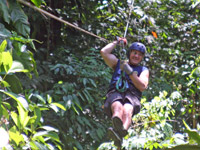 |
| Tom at high altitude... |
Costa Rica seems to have no end to natural beauty and adventure. We would hit the beach for a swim in the warm waters of the Pacific one day and then the next we would take a zip-line canopy tour in the hillside jungles. For those of you not familiar with this kind of tour, you hang from a steel cable (a body harness is attached to the cable) and go between trees at heights from 140 feet down to ground level. A real rush! The photo of me at left was taken by Alejandro at Dream Forest Canopy Tours.
Another rush – though an unintentional one - was riding the bikes across the “banana bridges” that span the many rivers on the west coast of Costa Rica. These are the bridges built in the late 19th century by the Del Monte and Chiquita fruit companies in order to move their produce to markets. They were abandoned about 80 years ago and little repair, if any, has been done to them. Asphalt had been laid down on one bridge, but after many years all that was left was a very high, rough center with enough of the metal cross beams missing to create 12 – 16 inch gaps open to the water below. We couldn’t see the big gaps until we got on the bridge and by then all you could do was pray that you didn’t have to stop because your foot may not stop until it hit the river.
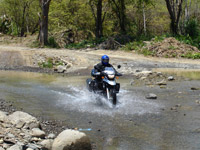 |
| and Lynne at sea level! |
We also had a river crossing on our way from Manuel Antonio to the town of Dominical. We watched a few 4WD’s cross and then I walked a 40-foot section and it since never got deeper than my knees we forged ahead. I just had to snap a shot of Lynne crossing it because it was a bit challenging.
After spending a few more days of swimming in the ocean and laying around poolside, we headed to our last stop in Costa Rica – back up into the mountains near the Savegre River. Riding from sea- level to 11,000 feet in about 2 hours turned hot, sweaty, riding gear into a cold shell with too many vents open. Add to that a little rain and temps in the high 50’s and we started to feel the chill. But before too long, we pulled off of the Pan-American Highway onto a road reminiscent of the dastardly ones in Guatemala - and immediately dropped 3,000 feet in about 3 miles. We then road another 6 miles through a winding emerald green valley until we arrived at the Sevegre Lodge.
Once again, the end justified the means. This lush valley proved to be a wonderful stopping point on our trip. The valley had its first human settlers only 50 years ago and our lodge was set up in the 1970’s by a German settler and his family to accommodate the nature lovers that were discovering the area. The number of bird species here was pretty amazing to see. Hummingbirds were so tame that you could sit down two feet from a feeder and they would go about their routines with no notice of you. There must have been at least six different varieties of the little guys, both smaller and larger species than we have seen in the US.
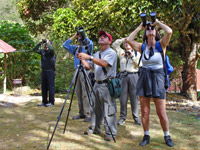 |
| What are those birds doing up there? |
The next day we went on a morning walk with a bird guide and spotted one of the most reclusive and colorful birds in the world, the Resplendent Quetzal. The quetzal boasts a brilliant red belly and bright blue and green feathers on his back and 2’ long curling tail. Lynne and I have never been bird watchers, but I found out that this hobby has quite a lot in common with the bird hunting I did while growing up in South Dakota. First similarity - the requisite costume of “blend-in beige” on all the participants. Next I noticed the familiar uplifted faces - constantly scanning the trees and brush. But in this instance, when a bird was spotted, the only sound you heard was the click of cameras instead of the blast of shotguns. Although our hosts and fellow “watchers” wouldn’t dream of shooting a bird, they had little trouble eating the rabbits served for dinner that night. I chose the fish and Lynne chose to have peanut butter crackers back at the room.
Well, all in all Costa Rica has been a great all-around experience. The diversity of climate, geography and activities kept us energized all the time. From the wake-up calls of the screaming howler monkeys to the late-night clatter of frogs and cicadas, our days were filled with lots of good times and friendly faces - which probably contributed to the fact that we always felt quite comfortable while traveling here.
Next stop is the last country in Central America – Panama.
Thoughs from Lynne
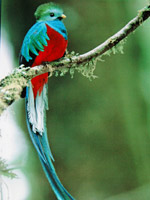 |
| The Resplendant Quetzal |
I was totally jazzed to see the Quetzal live in his own habitat – and on two separate occasions! I had begun to read about them while visiting Guatemala in 2004 (they are the national bird) - but I wasn’t able to see any on that trip. So the experience to see this gorgeous male and his two only slightly less magnificent females had me smiling all over. I owe great thanks to Mary Cole, who over dinner in Nicaragua suggested just the right place to find them. Muchisimas gracias, Mary.
PS - I cheated a bit on the photo at the right. It is actually a photo of a photo we found at the lodge. We weren't able to take a good composite and I wanted to share one here that better portrayed all his beauty. I put one of our photos on the gallery page.
Something else we noticed here in Costa Rica - for the first time since leaving the states, we have seen people exercising. Jogging in the streets, power-walking and bicycling for enjoyment rather than just for necessary transportation. We’re not sure why - perhaps it has something to do with Costa Rica having the highest per-capita income in Central America.
In San Jose, the Museo de Oro, Neumismatico, y Arte that Tom mentioned above is SO worth your time. They are all located in the central park of the city, cost only $7 for entrance to all three, and are fabulous.
Turns out that Costa Rica is the land of the pineapple. There are huge fields of them all across the countryside – they look like fields of mini-tequila (agave) plants and they smell wonderful! We have ridden through some FOUL smelling territory on this trip– in comparison, these fields were like riding through a patch of heaven.
And finally, a story we found worth thinking about –
A wise woman who was traveling in the mountains found a precious stone in a stream. The next day she met another traveler who was hungry, and the wise woman opened her bag to share her food. The hungry traveler saw the precious stone and asked the woman to give it to him. She did so without hesitation.
The traveler left, rejoicing in his good fortune. He knew the stone was worth enough to give him security for a lifetime.
But a few days later, he came back to return the stone to the wise woman. “I’ve been thinking,” he said. “I know how valuable the stone is, but I give it back in the hope that you can give me something more precious. Give me what you have within you that enabled you to give me this stone.”
Author Unknown, taken from Costa Rica Today newspaper, January 2006
Pura Vida.

Copyright © 2005 All content and photography are the property of Tom and Lynne Gefre.
Contact us if interested in publishing or reusing any material.